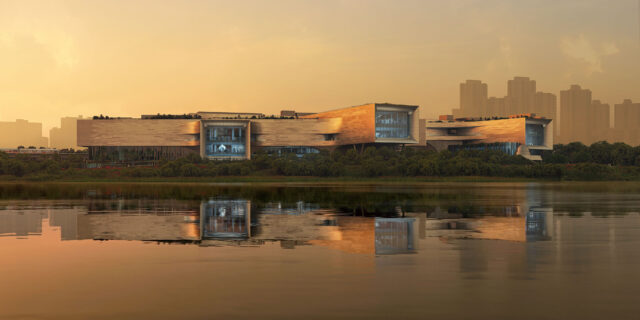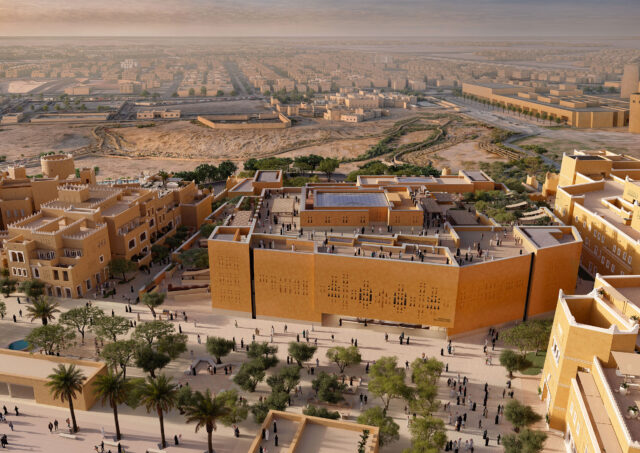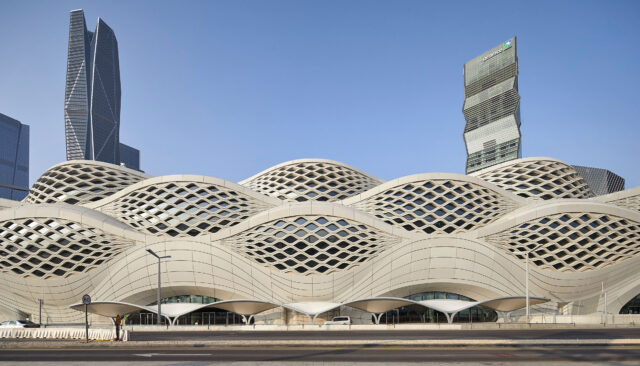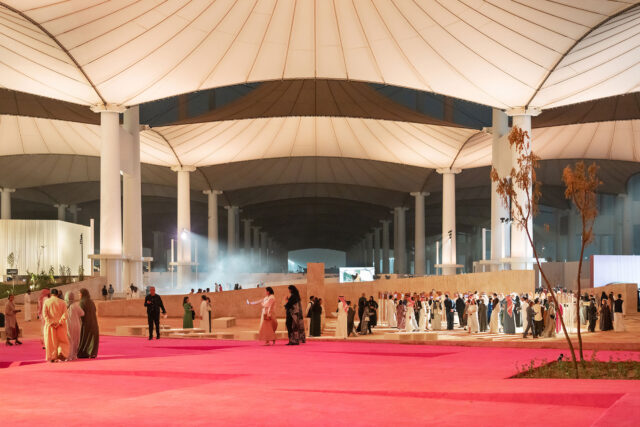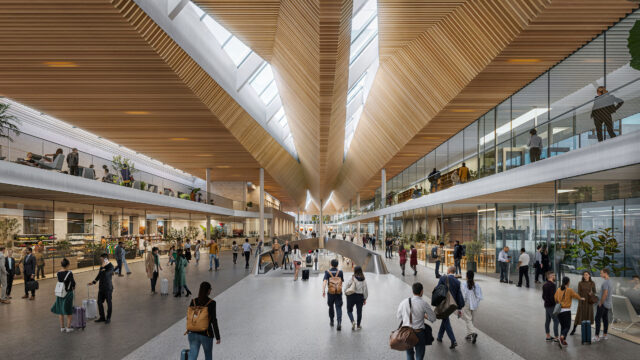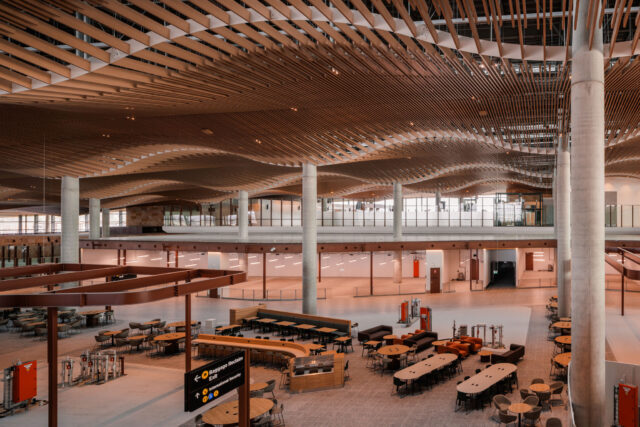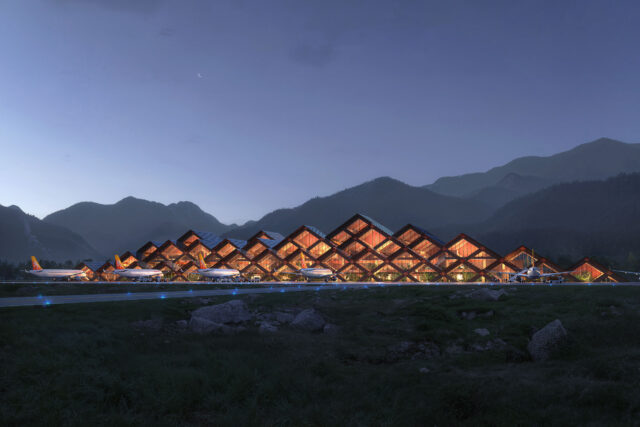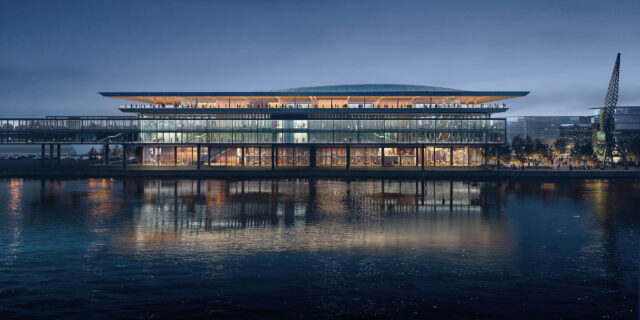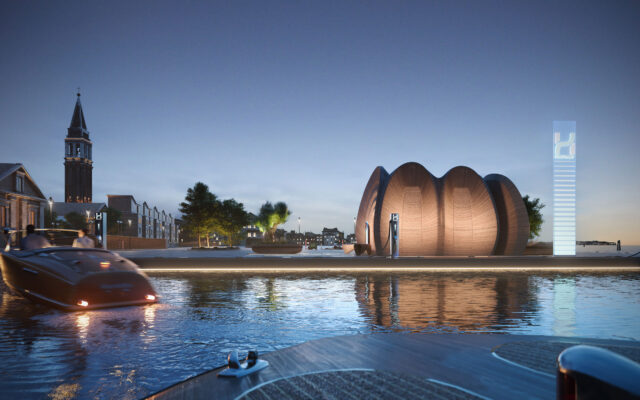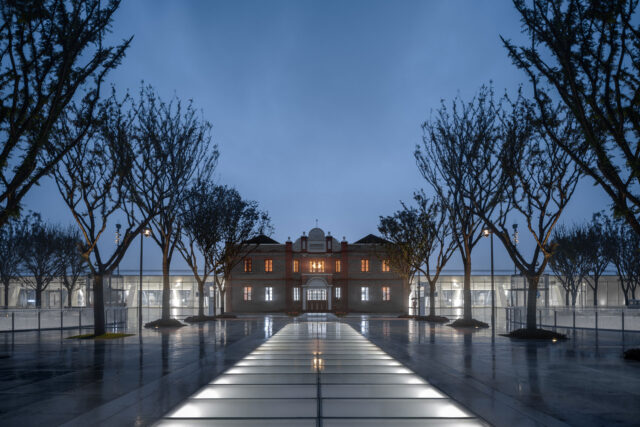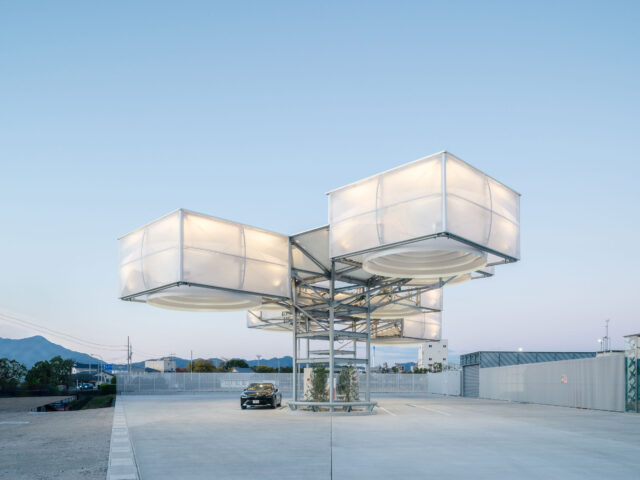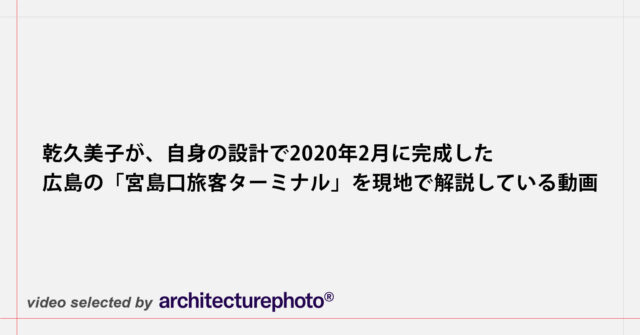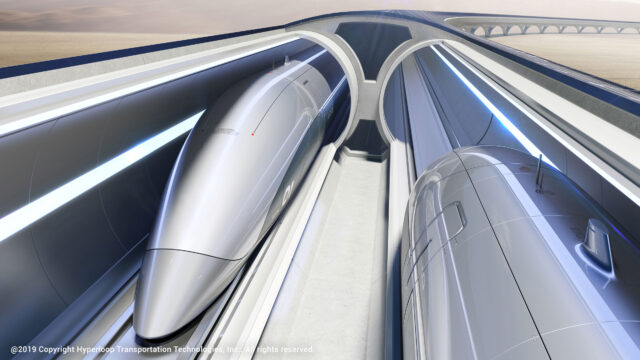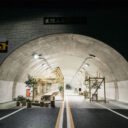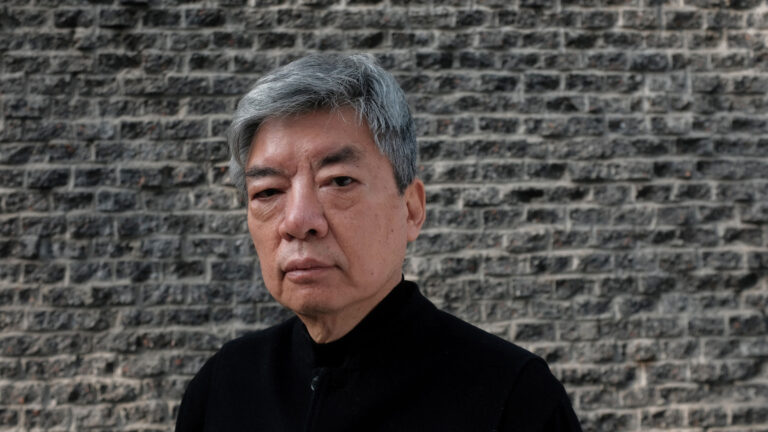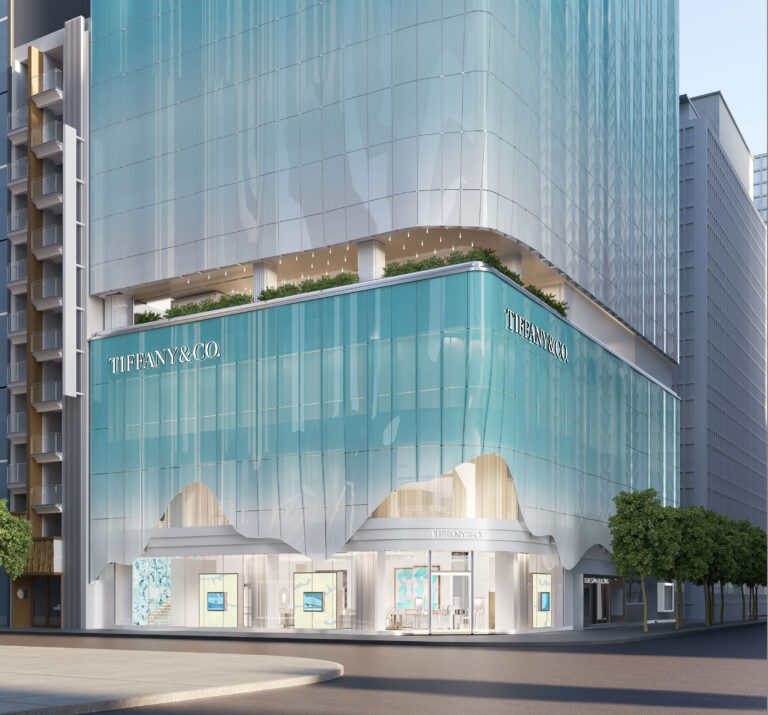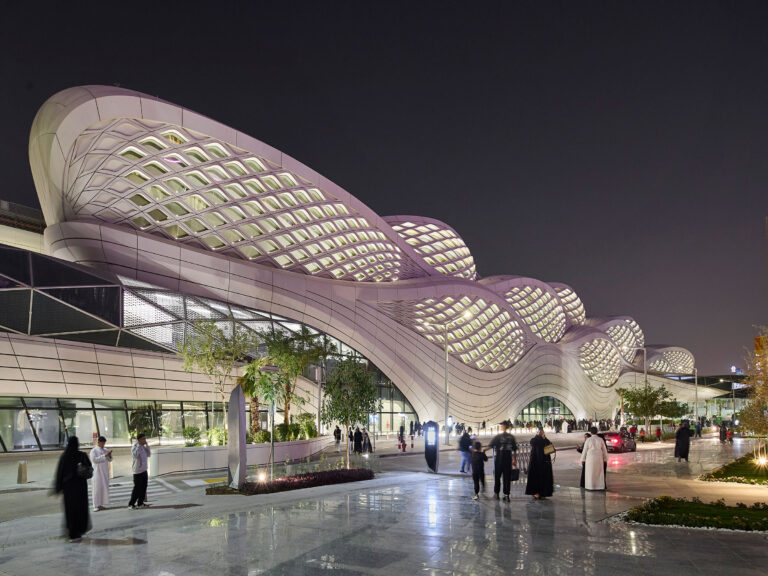
SHARE ザハ・ハディド・アーキテクツによる、サウジアラビア・リヤドの、地下鉄駅舎。国内初の公共交通機関で世界最長の無人運転鉄道の拠点駅。太陽熱の侵入を低減する多孔質なファサードは、地域の風土的建築の環境保護を現代的に再解釈したもの。開業11週間で1800万人以上が利用




ザハ・ハディド・アーキテクツが設計した、サウジアラビア・リヤドの、地下鉄駅舎「King Abdullah Financial District Metro Station」です。
国内初の公共交通機関で世界最長の無人運転鉄道の拠点駅です。太陽熱の侵入を低減する多孔質なファサードは、地域の風土的建築の環境保護を現代的に再解釈したもの。また、開業11週間で1800万人以上が利用しました。アーキテクチャーフォトでは、本建築の竣工直後の様子も特集記事として紹介しています。
開業から11週間で、1800万人以上の乗客がリヤドメトロを利用
世界最長の無人運転交通システムであるリヤドメトロは、6路線、85駅、総延長176キロメートルにわたる
ザハ・ハディド・アーキテクツが設計したキング・アブドラ・ファイナンシャル・ディストリクト駅は、このネットワークの主要な乗り換え拠点として機能します
交通渋滞の緩和、移動時間の短縮、リヤドの人口増加に伴う生活の質の向上をめざして設計されたリヤドメトロは、世界最長の無人運転交通システムです。この変革をもたらすネットワークは、6路線、85駅、総延長176キロメートルに及び、サウジアラビアの首都の主要地区、ビジネスセンター、文化的なランドマークを結んでいます。
リヤド市王立委員会(RCRC)によって計画された自動高速輸送システムであるリヤド・メトロは、住民と訪問者の両方のニーズを同様に満たしています。1日あたり最大360万人の乗客を収容できるこのネットワークは、市内の自動車での移動回数を減らし、持続可能な交通手段の利用を促進することを目指しています。
ザハ・ハディド・アーキテクツ(ZHA)が設計したキング・アブドラ・ファイナンシャル・ディストリクト(KAFD)地下鉄駅は、開業以来、300万人以上の乗客が利用しており、ネットワークの主要な乗換駅としての役割を強化しています。この駅はKAFDの終着点とキング・ハーリド国際空港を結び、また、KAFDモノレールのスカイブリッジへのアクセスも提供しています。4層にわたり6つの鉄道プラットフォームを備えたこの駅は、バスサービスとスムーズに接続し、王国の首都における重要な多目的交通ハブを形成するとともに、金融地区のための新たな屋内外の公共広場もつくりだしています。
リヤドの新しい地下鉄システムのアイデンティティに貢献するKAFD地下鉄駅のデザインは、接続性を最優先しています。この駅の鉄道、車両、歩行者の予測交通量は、内部の循環を最適化し混雑を避けるために、モデル化、マッピング、構造化されています。その結果得られた構成は、一連の対向する正弦波によって形成される三次元格子であり(駅の1日の利用者の動きの反復と頻度変化から生成)、建物内部の循環の軸となっています。
これらの正弦波は、超高強度コンクリートパネルで覆われた駅の外装にまで広がっています。ファサードの幾何学的な開口部は、地域のヴァナキュラーな建築に見られる伝統的な環境遮蔽の現代的な再解釈として、日射熱の吸収を抑えています。駅のファサードの構成は、砂漠の風が砂に描く模様に呼応しています。そこでは、複数の周波数と反響が、自然界にも見られる複雑な模様の繰り返しを生み出しています。
KAFD地下鉄駅は、反復、対称性、スケールを通じて高度に相関するエレメントのセットとして構成されています。この設計は、構造効率と環境性能を向上させるとともに、空間の質を損なうことなく建設プロセスを簡素化するために、開発の過程でZHAによって継続的に最適化されました。そして、外装の自立構造と、列車のプラットフォームや高架橋を支える駅の内部構造をシームレスに統合しています。
最小限のエネルギー需要で最適な快適性を実現するこの駅は、効果的なパッシブデザインの機能と、再生可能エネルギーで稼働する高効率の冷却システムを組み合わせたもので、1日の乗客数の変化に自動的に適応します。また、各プラットフォームのスライドドアパネルは、冷気を駅内に保ちます。KAFD地下鉄駅は、米国グリーンビルディング協会によるエネルギーおよび環境デザイン(LEED)ゴールド認証を取得しました。
以下の写真はクリックで拡大します



















以下、リリーステキストです。
Over 18 million passengers use Riyadh Metro in the network’s first eleven weeks of opening to the public
The world’s longest driverless transit system, the Riyadh Metro network spans over 176 kilometres across 6 lines and 85 stations
Designed by Zaha Hadid Architects, the King Abdullah Financial District Metro Station serves as a key interchange on the network
Designed to alleviate traffic congestion, shorten travel times and improve quality of life for Riyadh’s growing population, the Riyadh Metro network is the world’s longest driverless transit system. The transformative network spans over 176 kilometres across 6 lines and 85 stations, and connects key districts, business centres, and cultural landmarks in Saudi Arabia’s capital city.
An automated rapid transport system planned by the Royal Commission for Riyadh City (RCRC), the Riyadh Metro meets the needs of both residents and visitors alike. With a full maximum capacity of 3.6 million daily passengers, the network aims to reduce the number of car journeys throughout the city and encourage the use of sustainable modes of transport.
The King Abdullah Financial District (KAFD) Metro Station, designed by Zaha Hadid Architects (ZHA), has now served over three million passengers since its inauguration, reinforcing its role as a key interchange of the network. The station connects the KAFD terminus to King Khalid International Airport and provides access to the skybridge for the local KAFD monorail. Equipped with six rail platforms over four levels, the station seamlessly connects with bus services to create an important multi-modal transport hub for the Kingdom’s capital city, as well as new indoor and outdoor public plazas for the financial district.
Contributing to the identity of Riyadh’s new metro system, the KAFD Metro Station’s design prioritizes connectivity. The station’s predicted rail, car and pedestrian traffic has been modelled, mapped and structured to optimize internal circulation and avoid congestion. The resulting configuration is a three-dimensional lattice defined by a sequence of opposing sinewaves (generated from the repetition and frequency variation of the station’s daily traffic flows), which acts as the spine for the building’s circulation.
These sinewaves extend to the station’s exterior clad in ultra-high-performance concrete panels. The facade’s geometric perforations reduce solar gain as a contemporary reinterpretation of traditional environmental sheltering within the region’s vernacular architecture. The composition of the station’s facade echoes the patterns generated by desert winds in sand, where multiple frequencies and reverberation generate the complex repetition of patterns evident in the natural world.
The KAFD Metro Station is composed as a set of elements that are highly correlated through repetition, symmetry and scale. The design was continually optimized by ZHA throughout its development to increase structural efficiencies and environmental performance while also simplifying the construction process without compromising spatial quality; seamlessly integrating the self-supporting structure of its external envelope with the station’s internal structure which supports the train platforms and viaducts.
Providing optimal comfort at minimum energy demand, the station combines effective passive design features with a high-efficiency cooling system that is powered by renewables and automatically adjusts to differing passenger levels throughout the day, while sliding door panels on each platform retain cool air within the station. The KAFD Metro Station has achieved Leadership in Energy and Environmental Design (LEED) Gold certification by the US Green Building Council.
■建築概要
Project Team
Architect: Zaha Hadid Architects (ZHA)
ZHA Design: Zaha Hadid with Patrik Schumacher
ZHA Project Principal: Gianluca Racana
ZHA Project Director: Filippo Innocenti
ZHA Project Architect: Gian Luca Barone
ZHA Project Associate: Fulvio Wirz
ZHA Construction Support Leads: Marco Amoroso, Domenico di Francesco
ZHA Construction Support Services: Vincenzo Caputo, Abdel Halim Chehab, Marko Gligorov, Stefano Iacopini
ZHA Project Team: Marco Amoroso, Vincenzo Caputo, Abdel Halim Chehab, Lee Cubeddu, Rawan Al-Derjem, Domenico di Francesco, David Fogliano, Manuele Gaioni, Marko Gligorov, Subharthi Guha, Alexandros Kallegias, Lisa Kinnerud, Alexandre Kuroda, Stefano Iacopini, Carolina Lopez-Blanco, Jamie Mann, Mohammadali Mirzaei, Arian Hakimi Nejad, David Wolthers, Nicola McConnell, Mario Mattia, Massimo Napoleoni, Niki Okala, Carlos Parraga-Botero, Sohith Perera, Izis Salvador Pinto, Carine Posner, Neil Rigden, Paola Salcedo, Nima Shoja, Thomas Sonder, Vincenzo Reale, Kate Revyakina, Roberto Vangeli, Seungho Yeo
ZHA Competition Team: Alexandre Kuroda, Fei Wang, Lisa Kinnerud, Jorge Mendez-Caceres
───
Consultants
Structural Engineer: BuroHappold
Building Services Engineer: BuroHappold
Transport & Civil Engineers: BuroHappold
Fire Protection & Life Safety Engineer: BuroHappold
People Flow: BuroHappold
Acoustic Consultant: BuroHappold
Sustainability Consultant: BuroHappold
Lighting Consultant: BuroHappold
Facade Engineering: Newtecnic
Design Management: AECOM
Specification Consultant: AECOM
Cost Consultant: AECOM
Signage & Way Finding: Transport Design Consultancy
Safety Assessment: BH with Transsol
Development Engineer: Riyadh Metro Transit Consultants (RMTC)
Main Contractor: BACS Consortium
Independent Checking Engineer: Buro Veritas
Independant Safety Assessor: TUV Rheinland / ISARail Group
Transit Systems: Line 1 Siemens (BACS), Line 4&6 Alstom (FAST)
Viaducts: AECOM & TriPod-ssd (Line1), Atkins (Line 4&6)
Automatic Fare Collection: Indra
Structure Contractor: Saudi Lebanese Tarouk Contracting
MEP Contractor: Zamil
Interiors Contractor: DEPA
Elevators and Escalators: ThyssenKrupp
Facade Contractor: Permasteelisa Gartner Saudi Arabia
Landscape Contractor: DEPA

